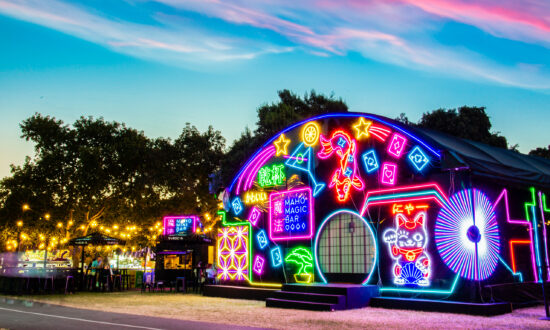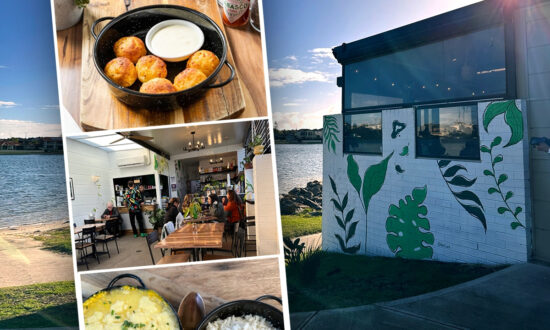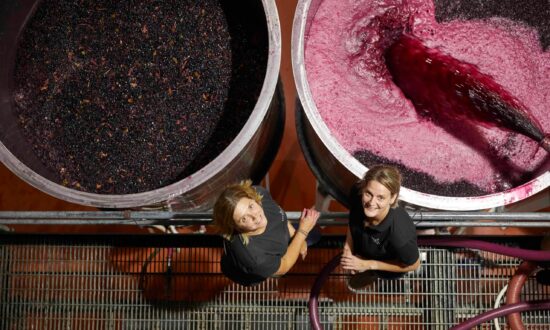It’s only natural the Adelaide Hills have risen to the top in Australian sparkling wine circles.
The region already has found itself at the centre of a contemporary revolution in fine wine Chardonnay and Pinot Noir. Both varieties are key to the creation of the finest bubbles made in the traditional method, inspired of course by the likes of French Champagne, so it’s no surprise that many Hills producers are now leading the way in Australian-made sparklings.
The Hills’ ascendancy has had a few recent boosts in confidence. Only last week, a $30 traditional method Hills sparkling – the Wicks Estate 2015 Pamela – won the trophy for best sparkling wine at the Melbourne Royal Wine Awards, triumphing over the best Tasmania and Victoria could present.
One of the key take-outs from that result, and after tasting it at home soon after the announcement, is that compared with anything French at that price and up to the $60 mark, Australian and specifically Adelaide Hills fizz offers extraordinary value and quality. This can’t be stressed enough as we head into the heady bubbles season.
In a more local demonstration of the rise and rise of Hills’ sparklings, that region’s own wine show announced its winners on the same day. Its sparkling trophy winner, the 2015 Mordrelle Blanc de Blancs, also won the gong for best single-vineyard wine. Meanwhile, the best wine of provenance for a producer submitting one wine from each of three vintages of varying age – considered by many as one of the most important trophies at the show – went to Deviation Road’s 2018, 2015 and 2011 Loftia.
It’s a ground-breaking moment to see a sparkling wine elevated to such prominence.
Why, one might ask, is it so?
The region’s name says a lot: the Hills lift up to 500m above sea level in many of the best fruit-bearing districts, which jigsaw across spectacular ridges and plunging valleys. Up and down, rising and falling through all points of the compass, the Adelaide Hills are dotted by hundreds of vineyards with a range of aspects prospering in subtly varying cool-climate conditions.
The result is a kaleidoscope of fruit parcels that can be directed specifically to fine sparkling wines, separate from their table wine cousins which still continue to shine in their own right.
The capacity for the Adelaide Hills to do both was always the plan for region pioneer Brian Croser when he established Petaluma in the Piccadilly Valley in 1978.
“It was all based on the concept that if you get into a cool enough region, you have the choice of doing both,” Croser recalls.
“We understood that there would be warmer sites and cooler sites, the former good for table wines and the latter for sparkling.”
The Croser traditional method sparkling line began by tapping into Chardonnay and Pinot Noir fruit mainly on south-facing slopes he had planted, with the first released in 1985. (The Croser sparklings continue today under the Petaluma brand that’s now owned by Accolade Wines.)
“You start with a mind’s eye picture and, in this case, that would be to come up with a Champagne,” Croser says. “But while you’re not quite going to get that, you are going to get close.”
There is a reason why the Hills, and specifically Croser’s favoured Piccadilly Valley district, produces wines that are different to Champagne.
“The wines (from there) demonstrate a very defined Piccadilly Valley fruit character – a terroir-driven fruit character – which is just lovely. You can pick it a mile away,” he says.
“And you learn to treasure that. It doesn’t fit the traditional Champagne style because it is about fruit and not the complexity of yeast and old oak fermentation and lees ageing characters that you get in Champagne.”
Deviation Road winemaker Kate Laurie agrees that it’s this regionally-driven style that has come to define the best of Adelaide Hills sparkling wines.
“I think people really enjoy the fruit characters we get in the Adelaide Hills, which really sets us apart,” Laurie says.
Her focus on fine sparkling wines is renowned in the region and beyond, having first created her much-loved Loftia Vintage Brut as well as the elite Beltana Blanc de Blancs in 2008. The latter’s 2014 release was named sparkling wine of the year in the latest Halliday Wine Companion.
The Halliday award recognition is an important marker of the region’s abilities, Laurie says, given so many regions are making sparkling wines now.
“It was a huge accolade, not only for us individually but for all the Hills.”

Kate Laurie has made her name with Adelaide Hills sparkling wines. Supplied image
Laurie works with around 13 different Hills’ sites mainly in the greater Piccadilly Valley district including Ashton, Summertown and Carey Gully and also closer to the Deviation Road winery and cellar door in Longwood. She utilises their cool, micro-climate variations in altitude and orientation to deliver the elegance and freshness for which her sparklings are renowned.
Her style is to tap into the natural fruit characters the Adelaide Hills gift the Chardonnay and Pinot Noir she harvests.
“I don’t need to seek out more flavour in the grapes here,” Laurie says. “I’m looking for finesse.”
Over time she has found the vineyard sites that deliver the lemon oil character she seeks as well as the citrus drive – the keys to her expression of Hills sparkling excellence.
Now, also, having seen how her traditional method styles develop as they age in their bottles in the winery before release, she has settled on their distinctive balance of flavour and acidity at five to six years for Beltana, less for Loftia, which has some Pinot Noir included.
Deviation Road’s sparkling portfolio has become a benchmark in the region in the past decade, – there are more than 50 now entering the Hills Wine show.
“It shows people are dedicated to making premium sparklings out of the Hills, and we are starting to see wines with a good time on lees because of that dedication.
“It’s fantastic, and because everyone became interested, we all now have stock on lees that we can showcase how the Hills can develop more complexity with that little bit of age.”
One of the region’s most ardent sparkling advocates, Xavier Bizot, agrees that there is a genuine culture of fine traditional-method wines from the Hills.
His DAOSA label has two styles, a Natural Reserve Pinot Noir/ Chardonnay blend and a current release 2017 Blanc de Blancs, both of which are indicative of the prowess of the Piccadilly Valley in making world-class sparklings.
“There is a real movement now,” Bizot says. “We have good drinkable wines from the transfer method in the Hills, but when you strive for excellence, you need to go to the traditional method.
“It is a forever expanding culture here, and there’s a massive opportunity to continue to improve as vines gain more age and the wines have more time to develop.
A passionate resident of Piccadilly Valley, he too supports the notion that the district’s sparkling wines are unique in their fruit expression, which makes them an attractive proposition in the marketplace.
“The Piccadilly Valley has a long history of making sparklings, and we have an advantage to be able to sell that story,” he says.
“We are a cool climate in Piccadilly, but we are also warmer than Champagne, so we can get some extra ripeness which gives us more flavour – in Pinot more strawberry characters and for Chardonnay you get more generous stone fruit flavours.
“What we can do in the Hills is blend the varieties, blend clones and vineyards with different altitude and aspects, and in Piccadilly Valley alone it’s wetter and cooler than elsewhere and we have different soils and all the different aspects.
“It’s fantastic – all of that makes it a great playground for sparkling winemaking.”

Australian/Argentinian winemaker and viticulturist, Martin Moran, among Chardonnay grapes at the vineyard of his company Mordrelle Wines in Lenswood. Supplied image
Bizot also notes that while he is ensconced in the Piccadilly district, many sites across the rest of the region are producing excellent sparklings as well.
Lobethal Road’s Maja Late Disgorged 2014 Blanc de Blancs, grown at Mt Torrens by Dave Neyle and Inga Lidums and made nearby at Lodestone winery by Michael Sykes and Warwick Billings, is a great example of a vineyard site that has been producing excellent sparklings for a decade, aided by a determination to foster serious bottle maturation to deliver further complexity.
“The Chardonnays we have here are a bit richer than the spikier characters in Piccadilly,” Neyle says. “We are at 475 metres here, and it’s a good spot for Chardonnay – we get good flavours in the vineyard.
“We’ve also worked at that about seven years on lees is a really good time to reach that balance of flavour and freshness, and it’s when classic yeast and biscuity characters start to come into the wine.
“We don’t get Champagne characters, and instead we get a freshness and nice acidity from our vineyard.”
That individuality of site and style is what has driven the long-lasting Henschke Johanne Ida Selma Blanc de Noir, an all-Pinot Noir sparkling from the family’s single vineyard at Lenswood.
The Henschke family’s sparkling program began in 1997, the first release in 2008 including 10 vintages of base wines. The latest bottling, in 2020, was the sixth release including 20 vintages in what Stephen Henschke calls a “multi-vintage” style.
He knows all too well that the Lenswood district has its challenges in terms of wet and cold weather; he also lost two vintages to bushfire damage after the December 2019 blaze that tore through that part of the Hills.
But he loves the diversity of blocks in the vineyard and how they can deliver varietal purity in cooler climate conditions.
“What I like about it is that it gives you that marginality challenge – it’s demanding, but incredibly rewarding,” Henschke says.
The Henschke sparkling’s Pinot focus reflects his own bias to the variety.
“Of all the sparklings made, the ones that really give me the greatest pleasure have a high percentage of Pinot Noir. That flavour complexity you get from Pinot Noir is more interesting, more beguiling than Chardonnay sparkling.
“And where we are on Croft ridge in Lenswood, it’s cold, wet and windy. It’s beautiful for Pinot Noir, which seems to love that part of the Hills.”
The vineyard has different aspects which provide site-specific characters, acting in many ways as a microcosm of the Hills’ many ridges and gullies, he says.
Site is the most significant factor, he says, as well as vintage differences, providing many variations in fruit characters that add to the great range of base wines that go into a multi-vintage style like the Johanne Ida Selma.
“The multi-vintage system gives us that greater complexity, with the structure and texture and balance that a single vintage can’t do,” he says.
In the end that one wine, from one vineyard in one district tells a much greater story in the Hills journey to becoming one of Australia’s top sparkling regions. The multitude of sites, their aspects and micro-climates, and the years of learning and development by the region’s producers have all come to fruition.
No wonder the Adelaide Hills has a sparkle in its eye.
TASTING NOTES

Wicks Estate 2015 Pamela Chardonnay Pinot Noir
Adelaide Hills / 12% / $30
With a top-flight capital city trophy behind it, this is amazing value. New winemaker Adam Carnaby, formerly at Seppelt, has finished off this wine to achieve superb balance and style that drinks with all the pleasures associated with domestic and French bubbles. Pale gold, classic Hills fruit notes of white peach, nectarine and crunchy white strawberry from a 70:30 mix of Chardonnay and Pinot Noir from the Wicks Estate vineyard at Woodside, a delicious lees-aged complexity without too much funk, and creamy palate feels. Super fresh with a faint tonic bitters finish – all the good things.
Mordrelle 2015 Blanc de Blancs “Reserva”
Adelaide Hills / 12% / Crown seal / $45
Tapping winemaker Martin Moran’s Argentinian roots, this is labelled “Metodo Tradicional”. Recently awarded trophies for best sparkling and best single-vineyard wine at the 2021 Adelaide Hills Wine Show, the all- Chardonnay fruit is from the family’s tiny block in Mylor. The wine spends six years in the bottle garnering a complex matrix of aromas and flavours associated with all the finest of international fizz. Nutty and yeast buns to start, developing a decent sway of aldehyde in the palate profile as well, the fruit is very much tightly wound in green apple and lemon juice notes, while the mousse is persistent and moreish. If you’re a ‘Grower Champagne’ kind of fiend, this is our local equivalent without a shadow of a doubt.
Deviation Road 2018 Loftia Vintage Brut
Adelaide Hills / 12.5% / $48
Just awarded the Wine of Provenance at the 2021 Adelaide Hills Wine Show for this current vintage as well as the 2015 and 2011 versions, the creation of this benchmark regional style shows winemaker Kate Laurie at the top of her game. Sourced from several sites, all above 500m altitudes in Lenswood and Piccadilly Valley districts, this 50:50 blend of Chardonnay and Pinot Noir displays more lime than lemon notes, with Pinot-derived rose petal suggestions adding their prettiness. Style complexities are subtle yet evident, just there after three years tirage with adulty aldehydes while a chalkiness in the mouthfeel is all about the Chardonnay. Tangy, delicious, moreish. Superb value. Its top-shelf sibling, the Beltana 2015 Blanc de Blancs ($105), has been just released as well, for an elite experience with the same vibe.
DAOSA Natural Reserve
Piccadilly Valley-Adelaide Hills / 12.9% / $50
This is denoted specifically Piccadilly Valley on the label, referring to several vineyard sites owned or managed by Xavier Bizot in his preferred area of the Hills. The finest of sparkling wines can come from the most skilled blending of varieties and vintages, as happens here: a 72:28 mix of Pinot Noir and Chardonnay, 84% from the 2019 vintage with reserve wines from 2018 and 2017 making up the rest. This provides judicious complexities in a light tonic mode: white crunchy strawberry fruit tang along with fresh ripe lemons and limes from the high-altitude Chardonnay. Two years in the bottle to settle and knit encourages a fine mousse in the glass while delivering hyper refreshment to the palate. This has plenty of flavour as well, an adult lemonade yet moreishly dry drinking. It’s available in magnum as well, while a higher-end DAOSA Blanc de Blancs 2017 ($90) is seriously good as well.
Lobethal Road Maja 2014 Blanc de Blancs (Late Disgorged)
Adelaide Hills / 11.6% / $60
From Lobethal Road’s estate vineyard at Mount Torrens, this wine is hand-picked, whole bunch pressed and made in the traditional method, spending seven years maturing on its lees before a recent disgorgement. It’s a great example of the late disgorged style, gathering fascinating yeast bun characters over time yet with a lower sweetness level dosage, remaining extraordinarily fresh and bright, ultimately with a zesty citrus palate profile and salivating finish. A terrific aperitif to accompany oysters, paté and soft cheeses.

Get InReview in your inbox – free each Saturday. Local arts and culture – covered.
Thanks for signing up to the InReview newsletter.
Henschke Johanne Ida Selma Blanc de Noir MD
Lenswood-Adelaide Hills / 11.5% / Crown Seal / $62
From Henschke’s single vineyard high in the Lenswood sub-region, this is an all-Pinot Noir wine without skin contact, hence it remains a white sparkling, assembled in 2019 from 20 different vintages (1997 to 2017) before a mature disgorgement. The depth of flavour and texture from this combination of methods is what stands out, having developed an incredible mix of nougat-like creamy and nutty layers along with a complex matrix of Pinot Noir-based fruit notes, raspberry and rose yet still retaining a citrus-like core. The built-in years of maturity also mean the palate texture is creamy and soft, and the finish soft and cushiony. A uniquely wonderful wine.
Read more of Tony Love’s wine reviews and stories here.
Support local arts journalism
Your support will help us continue the important work of InReview in publishing free professional journalism that celebrates, interrogates and amplifies arts and culture in South Australia.
Donate Here




